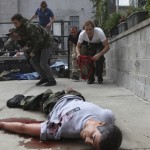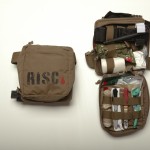Today is 11 years since the dates 9/11 became forever a part of our collective memories, world-wide, and we remember.
Innocents who had not officially enlisted that day to be warriors lost lives and affected countless others lives in our communities. We also remember those who rushed in selflessly to help, to try to save lives.
Military Success Network respectfully remembers.
We’re also remembering those who answer the call of duty to capture history, journalists who help us make sense of the world around us. If the life saving skills of any one of the brave police, fireman or other heroes who rushed to help in 9/11 were present in peers at a conflict zone, it is likely that some might not succumb to wounds and die.
““Please check out this non-profit started by Sebastian Junger,” says Nate Brookshire, Military Success Network co-founder. “I, for one, appreciate the perspective combat journalist give us. Without their putting themselves in harm’s way, the soldier’s perspective would rarely be seen. The documentary Restrepo is a must see. The film is worth your time.”
“Sebastian collaborated with Tim Hetherington on the documentary released in 2010. Tim was killed in April 2011 covering the conflict in Libya. This is a wonderful way to keep his memory alive.”
Below we share Sebastian’s personal message about founding *RISC *Reporters Instructed in Saving Colleagues
“During the siege of Misrata by Colonel Gaddafi’s forces last April, a single mortar shell landed on the frontlines of Tripoli Street and changed journalism – and my life – forever. In addition to killing and wounding many Libyan fighters, an American photojournalist named Chris Hondros was mortally wounded, and my good friend and colleague, Tim Hetherington, was hit by shrapnel in the groin.
Tim’s wound did not have to be fatal, but it killed him nevertheless. His femoral artery had been cut, and although that is an extremely serious injury, there are things that can be done to prolong life. Unfortunately, none of the journalists or rebels around him knew what to do, and Tim bled out and died in the back of a pickup truck on the way to the Misrata hospital. Tim is not the first friend I have lost in combat, but his death was certainly the most devastating. It has prompted me to start a medical training program for freelancer journalists so that the next tragedy can be averted. Our course is modeled after informal training that Tim and I received in Afghanistan and is taught by experienced medics, many with extensive combat experience.
The course lasts three days and covers basic procedures for saving someone’s life on the battlefield: clearing air passageways, stopping or slowing bleeding from wounds, stopping air leakage into the chest cavity from a chest wound and transporting the injured person to a medical facility.
Each graduate receives a combat medical kit with our RISC logo on the side and is expected to keep it on their person at all times while in a war zone. We plan to offer courses in New York, London and Beirut, and all costs are born by charitable donations. Students only pay their own travel and food expenses.
It is my hope that soon, first aid training and preparedness will be the industry norm, like having a flak jacket and helmet. It is only a matter of time until another journalist receives a wound like Tim’s, and I want to do everything I can to spare others what his friends and family endured last April.”
-Sebastian Junger
FAST FACTS on RISC:
RISC is a nonprofit organization that provides emergency medical training to freelance conflict journalists.
- Founded in 2011 after the death of acclaimed photographer Tim Hetherington who died from wounds he suffered in a mortar attack while covering the conflict in Libya.
- It is believed that first aid might have saved his on the short ride to the hospital.
- Most journalists in conflict zones are not trained in first aid
- Since its launch in April 2012 more than 200 applications for training have come in from journalists around the world.
- RISC covers instruction fees and accommodations for the reporters, and provides each graduate with a comprehensive medical kit similar to that carried by military combat medics.
On the one year anniversary of Tim Hetherington’s death, RISC held its first training in New York at the Bronx Documentary Center in April 2012. The organization contracted Wilderness Medical Associates International’s instructors to train 24 experienced freelance conflict journalists in battlefield first aid.
RISC is a 501(c)(3) organization. Its corporate sponsors include:
• ABC News
• CNN
• National Geographic
• Vanity Fair
• Conde Nast
• Getty Images
Visit http://risctraining.org


Sebastian Junger sent out a message asking friends and colleagues to consider supporting RISC (Reporters Instructed in Saving Colleagues). The message struck me as I read his words describing the loss of his friend, Tim Hetherington, in Libya.
It gave me much pause. I have interacted with many reporters during my career. From arguing with David Bloom in Bosnia about remaining in the press box during a Presidential visit to loading up my platoon to avoid contact with Lara Logan in Tal Afar, Iraq. I have also used open source information from Michael Yon (who does not consider himself a journalist) as he was reporting across town in Mosul, Iraq. Then there was the surreal experience of being tasked to escort Erik Swabb around Baghdad to later realize he was reporting for a Harvard newspaper.
On the latest deployment I have stood shoulder to shoulder with CJ Chivers as Tyler Hicks snapped photos of F-18 pilots as they prepared to launch from an Aircraft Carrier.
I have matured in my interaction with reporters, and I can attest to their zeal in getting the story. This passion places them in harm’s way. Often they are insufficiently equipped and trained in basic medical procedures. In my opinion, this project honors the memory of a man who gave his life to share the reality of war.
This day I remember and I am grateful that we have dedicated journalists that stand beside our service members to capture history. Please comment and tell your story or just share your thoughts.
Thank you Nate for your comments and your bringing us into the world, ‘on the ground and at the front’ of what most of us see on the evening news. Yours is the unedited, unretouched experience. I value such experiences greatly. Indeed, we need to share one story at a time.. person to person.
Front line folks are charged with seeing and sensing as much as they can, for the rest of us. It is humbling, and almost shaming to be able to choose to consume, analyze, edit on our own schedules. The passions and patriotic duties of others do much to create our choices and to help us understand what the costs really are.
Helena — Thank you so much for sharing this story (which I have already tweeted).
Although I had seen the documentary RESTREPO (and feature it on my site at http://www.insupportofourtroops.com/restrepo-documentary/ ), I had no idea about the initiative Reporters Instructed in Saving Colleagues.
Very appropriate article to share on the anniversary of 9/11.
Phyllis,
Your writing and websites are a resource we look to
Thank you for your comments and support.
Nate,
After reading the article, I realized I never considered this particular patient/casualty population. As a tactical paramedic being in the sandbox and mountains for some years now, I didn’t have the unique perspective I have now. I was in Baghdad when Kimberly Dozier from CBS was critically injured. I had not thought about the fact journalists would specifically need this critical training. EVERYONE going into harm’s way should be provided the knowledge and skills to respond to these types of events. Nobody is immune from being injured.
I personally feel journalists need this initial training as well as continued education in basic trauma life support. There are many excellent programs out there and they need to learn what to do for themselves and each other. The first time they see traumatic injuries should be in a controlled and simulated training environment of realistic training. I’m not aware of any journalists traveling with certified tactical medics, so the burden for this responsibility is entirely theirs to share.
Mark,
Thanks for your comments. Your experience and expertise in this matter is of great value to us all. Sebastian is taking a tragedy and effectively applying a sound course of action to save lives.
I appreciate you taking the time to weigh-in.
The Best,
Nate
Mark,
I reread your comment and your wise suggestion for journalists to be exposed to trauma and trained in response to it, in a controlled environment, first, if possible.
It was especially meaningful on the repeat reading because in various small meetings and conversations I heard many stories at the Military Writer’s Conference. I attended with Nate and his co-author of “Hidden Wounds: A Soldier’s Burden”, Marius Tecoanta.
At this event, the Sangria Summit, Kelly Kennedy told her story on writing her book: “They Fought For Each Other.” She is both a veteran of multiple deployment and a professional journalist.
Trauma takes on many faces and lingers far longer than we might expect, whether we are experiencing it personally or observing it in others we hope can ‘just get on with it.’ Thank you for your comment. It allowed me to go deeper in my understanding of the stories shared by the military men and women.
Helena